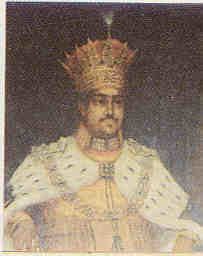Name Ghazi-ud-Din Shah Siblings Muhammad Ali Shah | Grandparents Shuja-ud-Daula Parents Saadat Ali Khan II | |
 | ||
Reign 11 July 1814 – 19 October 1818 Successor Naser ad-Din Haydar Solayman Jah Shah Reign 19 October 1818 – 19 October 1827 Predecessor Yamin ad-Dowla Nazem al-Molk Sa`adat `Ali Khan II Bahadur Similar People Saadat Ali Khan II, Shuja‑ud‑Daula, Saadat Ali Khan I, Siraj ud‑Daulah | ||
Children Nasir-ud-Din Haidar Shah | ||
Ghazi-ud-Din Haidar Shah (Hindi: ग़ाज़िउद्दीन हैदर शाह Urdu:غازی الدیں حیدر شاہ) (b. c. 1769 – d. 19 October 1827) was the last nawab wazir of Oudh from 11 July 1814 to 19 October 1818 and first King of Oudh from 19 October 1818 to 19 October 1827.
Contents
Life
He was the third son of Nawab Saadat Ali Khan and Mushir Zadi was his mother. He became Nawab Wazir of Oudh on 11 July 1814 after the death of his father. In 1818, under the influence of Warren Hastings, the British Governor of the Presidency of Fort William (Bengal), he declared himself as the independent Padshah-i-Awadh (King of Oudh). He died in the Farhat Bakhsh palace in Lucknow in 1827. He was succeeded by his son Nasir-ud-Din Haider after his death.
Patron of art and culture
Several monuments in Lucknow were constructed by Ghazi-ud-Din Haidar. He built the Chattar Manzil palace and added the Mubarak Manzil and the Shah Manzil in the Moti Mahal complex for better viewing of the animal fights. He also constructed the tombs of his parents, Sadat Ali Khan and Mushir Zadi Begum. For his European wife, he constructed a European style building known as the Vilayati Bagh. Another creation, the Shah Najaf Imambara (1816), his mausoleum, on the bank of the Gomti is a copy of the fourth Caliph Ali's burial place in Najaf, Iraq. His three wives, Sarfaraz Mahal, Mubarak Mahal and Mumtaz Mahal were also buried here.
Ghazi-ud-Din first appointed a British artist, Robert Home (1752–1834) as his court artist and after his retirement in 1828, he appointed another Briton, George Duncan Beechey (1798–1852) as his court artist. In 1815, Raja Ratan Singh (1782–1851), a noted astronomer, poet and scholar of Arabic, Persian, Turkish, Sanskrit and English joined his court. Because of his initiative, a royal litho printing press in Lucknow was set up in 1821 and the Haft Qulzum, a dictionary and grammar of the Persian language in two volumes was published from this press in the same year.
Coins of Ghazi-ud-Din
After declaring himself as King, Ghazi-ud-Din Haidar Shah issued coins on his name instead of the Mughal emperor, Shah Alam II from AH 1234 (1818). His coins were completely different from his predecessors. The most important feature of his coinage was the introduction of his coat of arms on the reverse of coin, consisting of two fish facing each other, two tigers each holding a pennon for support and a Katar (a small dagger) surmounted by a crown symbolizing the king.
